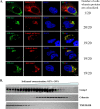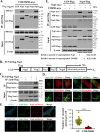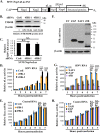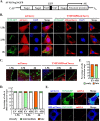TMEΜ45B Interacts with Sindbis Virus Nsp1 and Nsp4 and Inhibits Viral Replication
- PMID: 35938871
- PMCID: PMC9472651
- DOI: 10.1128/jvi.00919-22
TMEΜ45B Interacts with Sindbis Virus Nsp1 and Nsp4 and Inhibits Viral Replication
Abstract
Alphavirus infection induces the expression of type I interferons, which inhibit the viral replication by upregulating the expression of interferon-stimulated genes (ISGs). Identification and mechanistic studies of the antiviral ISGs help to better understand how the host controls viral infection and help to better understand the viral replication process. Here, we report that the ISG product TMEM45B inhibits the replication of Sindbis virus (SINV). TMEM45B is a transmembrane protein that was detected mainly in the trans-Golgi network, endosomes, and lysosomes but not obviously at the plasma membrane or endoplasmic reticulum. TMEM45B interacted with the viral nonstructural proteins Nsp1 and Nsp4 and inhibited the translation and promoted the degradation of SINV RNA. TMEM45B overexpression rendered the intracellular membrane-associated viral RNA sensitive to RNase treatment. In line with these results, the formation of cytopathic vacuoles (CPVs) was dramatically diminished in TMEM45B-expressing cells. TMEM45B also interacted with Nsp1 and Nsp4 of chikungunya virus (CHIKV), suggesting that it may also inhibit the replication of other alphaviruses. These findings identified TMEM45B as an antiviral factor against alphaviruses and help to better understand the process of the viral genome replication. IMPORTANCE Alphaviruses are positive-stranded RNA viruses with more than 30 members. Infection with Old World alphaviruses, which comprise some important human pathogens such as chikungunya virus and Ross River virus, rarely results in fatal diseases but can lead to high morbidity in humans. Infection with New World alphaviruses usually causes serious encephalitis but low morbidity in humans. Alphavirus infection induces the expression of type I interferons, which subsequently upregulate hundreds of interferon-stimulated genes. Identification and characterization of host antiviral factors help to better understand how the viruses can establish effective infection. Here, we identified TMEM45B as a novel interferon-stimulated antiviral factor against Sindbis virus, a prototype alphavirus. TMEM45B interacted with viral proteins Nsp1 and Nsp4, interfered with the interaction between Nsp1 and Nsp4, and inhibited the viral replication. These findings provide insights into the detailed process of the viral replication and help to better understand the virus-host interactions.
Keywords: Sindbis virus; TMEM45B; virus host interaction.
Conflict of interest statement
The authors declare no conflict of interest.
Figures








Similar articles
-
Novel Mutations in nsP2 Abolish Chikungunya Virus-Induced Transcriptional Shutoff and Make the Virus Less Cytopathic without Affecting Its Replication Rates.J Virol. 2019 Feb 5;93(4):e02062-18. doi: 10.1128/JVI.02062-18. Print 2019 Feb 15. J Virol. 2019. PMID: 30487275 Free PMC article.
-
Palmitoylated Cysteines in Chikungunya Virus nsP1 Are Critical for Targeting to Cholesterol-Rich Plasma Membrane Microdomains with Functional Consequences for Viral Genome Replication.J Virol. 2020 May 4;94(10):e02183-19. doi: 10.1128/JVI.02183-19. Print 2020 May 4. J Virol. 2020. PMID: 32132240 Free PMC article.
-
nsP4 Is a Major Determinant of Alphavirus Replicase Activity and Template Selectivity.J Virol. 2021 Sep 27;95(20):e0035521. doi: 10.1128/JVI.00355-21. Epub 2021 Jul 28. J Virol. 2021. PMID: 34319783 Free PMC article.
-
Alphavirus polymerase and RNA replication.Virus Res. 2017 Apr 15;234:44-57. doi: 10.1016/j.virusres.2017.01.007. Epub 2017 Jan 16. Virus Res. 2017. PMID: 28104453 Review.
-
Drugs targeting structural and nonstructural proteins of the chikungunya virus: A review.Int J Biol Macromol. 2024 Mar;262(Pt 2):129949. doi: 10.1016/j.ijbiomac.2024.129949. Epub 2024 Feb 2. Int J Biol Macromol. 2024. PMID: 38311132 Review.
Cited by
-
TMEM160 Promotes Tumor Growth in Lung Adenocarcinoma and Cervical Adenocarcinoma Cell Lines.Int J Mol Sci. 2025 Jan 27;26(3):1097. doi: 10.3390/ijms26031097. Int J Mol Sci. 2025. PMID: 39940865 Free PMC article.
-
Antiviral Activity of Selective Estrogen Receptor Modulators against Severe Fever with Thrombocytopenia Syndrome Virus In Vitro and In Vivo.Viruses. 2024 Aug 20;16(8):1332. doi: 10.3390/v16081332. Viruses. 2024. PMID: 39205306 Free PMC article.
-
The transmembrane proteins (TMEM) and their role in cell proliferation, migration, invasion, and epithelial-mesenchymal transition in cancer.Front Oncol. 2023 Oct 23;13:1244740. doi: 10.3389/fonc.2023.1244740. eCollection 2023. Front Oncol. 2023. PMID: 37936608 Free PMC article. Review.
-
Identification of RACK1 as a novel regulator of non-structural protein 4 of chikungunya virus.Acta Biochim Biophys Sin (Shanghai). 2024 May 29;56(10):1425-1436. doi: 10.3724/abbs.2024073. Acta Biochim Biophys Sin (Shanghai). 2024. PMID: 38813597 Free PMC article.
References
-
- Nasar F, Palacios G, Gorchakov RV, Guzman H, Da Rosa AP, Savji N, Popov VL, Sherman MB, Lipkin WI, Tesh RB, Weaver SC. 2012. Eilat virus, a unique alphavirus with host range restricted to insects by RNA replication. Proc Natl Acad Sci USA 109:14622–14627. 10.1073/pnas.1204787109. - DOI - PMC - PubMed
Publication types
MeSH terms
Substances
LinkOut - more resources
Full Text Sources
Molecular Biology Databases

